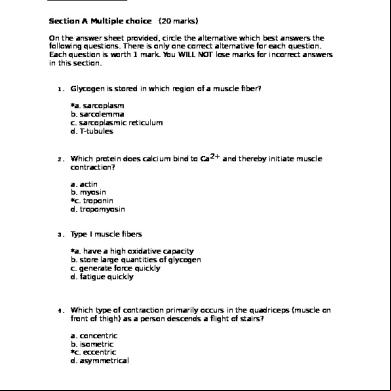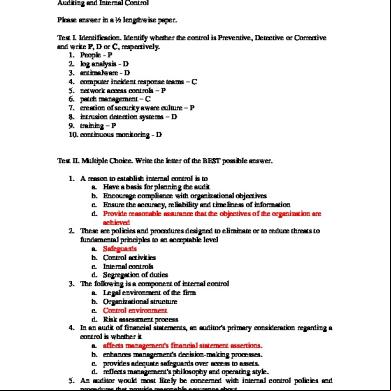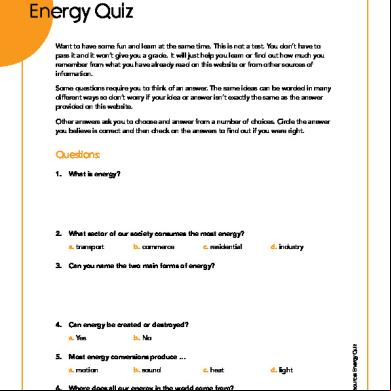Exercise Physiology 1 Example Quiz (with Answers) 1f1h3u
This document was ed by and they confirmed that they have the permission to share it. If you are author or own the copyright of this book, please report to us by using this report form. Report 2z6p3t
Overview 5o1f4z
& View Exercise Physiology 1 Example Quiz (with Answers) as PDF for free.
More details 6z3438
- Words: 900
- Pages: 7
EXERCISE PHYSIOLOGY 1 Name __________________________________ ______________________
EXAMPLE QUIZ Student ID
Section A Multiple choice (20 marks) On the answer sheet provided, circle the alternative which best answers the following questions. There is only one correct alternative for each question. Each question is worth 1 mark. You WILL NOT lose marks for incorrect answers in this section. 1. Glycogen is stored in which region of a muscle fiber?
*a. sarcoplasm b. sarcolemma c. sarcoplasmic reticulum d. T-tubules 2. Which protein does calcium bind to Ca2+ and thereby initiate muscle
contraction?
a. actin b. myosin *c. troponin d. tropomyosin 3. Type I muscle fibers
*a. have a high oxidative capacity b. store large quantities of glycogen c. generate force quickly d. fatigue quickly
4. Which type of contraction primarily occurs in the quadriceps (muscle on
front of thigh) as a person descends a flight of stairs? a. concentric b. isometric *c. eccentric d. asymmetrical
5. Why does a sarcomere that is too short or too stretched produce less
force?
a. Thick filaments get damaged. b. Thin filaments become unraveled. *c. Not as many cross-bridges can form. d. The reduction in force is negligible and can be ignored.
6. During the 400 m sprint (50-60 sec in duration), which two metabolic
pathways will be primarily involved in synthesising ATP for muscle contraction? a. ATP-PCr, oxidative phosphorylation b. glycolysis, β-oxidation *c. ATP-PCr, glycolysis d. β-oxidation, oxidative phosphorylation
7. The somatic nervous system most specifically belongs to which division of
the nervous system? a. peripheral b. autonomic c. sensory *d. motor
8. If a membrane potential changes from -70 mV to -65 mV, this is an
example of
*a. depolarization b. repolarization c. hyperpolarization d. threshold polarization
9. Action potentials travel fastest on axons that are
*a. myelinated and large b. unmyelinated and large c. myelinated and small d. unmyelinated and small
10. The sympathetic nervous system would contribute to
*a. increased heart rate b. skeletal muscle contraction c. skeletal muscle inhibition d. increased energy conservation
11. As Respiratory Exchange Ratio values approach 1.0,
a. the body is at rest b. physical exertion levels are moderate *c. glucose/glycogen metabolism is maximal or near maximal d. glycogen is depleted and metabolism is mostly of fat
12. How does heat build up in muscle contribute to fatigue?
*a. hastens glycogen depletion b. lowers muscle pH c. inhibits nerve impulse transmission to the muscle fiber d. inhibits gluconeogenesis
13. Which chamber of the heart has the thickest walls?
a. right atrium b. left atrium c. right ventricle *d. left ventricle
14. During exercise chemoreceptors stimulate an increase in breathing rate
and depth, the primary drive for this increase is because a. more oxygen is needed *b. excess CO2 needs to be “blown off” or exhaled c. blood pH was too alkaline d. PO2 was too high
15. Which of the following can be used to estimate maximum heart rate?
a. maximal cardiac output or maximal stroke volume b. 220 - age in years *c. 208 -(0.7 x age in years) d. the lactate threshold
16. Compared to untrained individuals, trained endurance athletes have
a. higher maximal heart rates b. higher resting cardiac outputs c. higher resting heart rates *d. higher maximal stroke volumes
17. During endurance exercise, total peripheral vascular resistance
a. increases greatly b. increases somewhat c. stays constant *d. decreases 18. During prolonged exercise at a fixed work load heart rate steadily
increases due to a phenomenon known as cardiovascular drift. This cardiovascular drift is primarily associated with a. increased muscle sympatholysis b. increased cardiac output *c. decreased venous return d. decreased afterload
19. Which athlete is the most powerful?
a. Athlete A (bench presses 100 kg over 0.5 m in 0.5 s) b. Athlete B (bench presses 200 kg over 0.5 m in 1.0 s) c. Athlete C (bench presses 300 kg over 0.5 m in 1.5 s) *d. They are all equally powerful
20. If the rate of oxidative production of ATP is low, then
*a. aerobic power is low b. aerobic power is high c. anaerobic power is low d. anaerobic power is high
Section B (10 marks) 1. Explain the differences between concentric, isometric and eccentric muscle contractions? (5 marks) Concentric contraction: Force is developed while the muscle is shortening Isometric contraction: Force is generated but the length of the muscle is unchanged Eccentric contraction: Force is generated while the muscle is lengthening
2.
There are a number of reasons as to why we might conduct a physiological test on an individual. List 5 of these reasons (5 marks) Any 5 of the following will do: Individual training prescription Detection of individual deficiencies, strengths and response rates Incentives/goals Education Analysis of energy demands Establish trends and patterns of distribution in population Health assessment
Section A Answer Key Student ID Given Name/s
Surname
1.
A
B
C
D
2.
A
B
C
D
3.
A
B
C
D
4.
A
B
C
D
5.
A
B
C
D
6.
A
B
C
D
7.
A
B
C
D
8.
A
B
C
D
9.
A
B
C
D
10.
A
B
C
D
11.
A
B
C
D
12.
A
B
C
D
13.
A
B
C
D
14.
A
B
C
D
15.
A
B
C
D
A
B
C
D
17.
A
B
C
D
18.
A
B
C
D
19.
A
B
C
D
16.
20.
A
B
C
D
EXAMPLE QUIZ Student ID
Section A Multiple choice (20 marks) On the answer sheet provided, circle the alternative which best answers the following questions. There is only one correct alternative for each question. Each question is worth 1 mark. You WILL NOT lose marks for incorrect answers in this section. 1. Glycogen is stored in which region of a muscle fiber?
*a. sarcoplasm b. sarcolemma c. sarcoplasmic reticulum d. T-tubules 2. Which protein does calcium bind to Ca2+ and thereby initiate muscle
contraction?
a. actin b. myosin *c. troponin d. tropomyosin 3. Type I muscle fibers
*a. have a high oxidative capacity b. store large quantities of glycogen c. generate force quickly d. fatigue quickly
4. Which type of contraction primarily occurs in the quadriceps (muscle on
front of thigh) as a person descends a flight of stairs? a. concentric b. isometric *c. eccentric d. asymmetrical
5. Why does a sarcomere that is too short or too stretched produce less
force?
a. Thick filaments get damaged. b. Thin filaments become unraveled. *c. Not as many cross-bridges can form. d. The reduction in force is negligible and can be ignored.
6. During the 400 m sprint (50-60 sec in duration), which two metabolic
pathways will be primarily involved in synthesising ATP for muscle contraction? a. ATP-PCr, oxidative phosphorylation b. glycolysis, β-oxidation *c. ATP-PCr, glycolysis d. β-oxidation, oxidative phosphorylation
7. The somatic nervous system most specifically belongs to which division of
the nervous system? a. peripheral b. autonomic c. sensory *d. motor
8. If a membrane potential changes from -70 mV to -65 mV, this is an
example of
*a. depolarization b. repolarization c. hyperpolarization d. threshold polarization
9. Action potentials travel fastest on axons that are
*a. myelinated and large b. unmyelinated and large c. myelinated and small d. unmyelinated and small
10. The sympathetic nervous system would contribute to
*a. increased heart rate b. skeletal muscle contraction c. skeletal muscle inhibition d. increased energy conservation
11. As Respiratory Exchange Ratio values approach 1.0,
a. the body is at rest b. physical exertion levels are moderate *c. glucose/glycogen metabolism is maximal or near maximal d. glycogen is depleted and metabolism is mostly of fat
12. How does heat build up in muscle contribute to fatigue?
*a. hastens glycogen depletion b. lowers muscle pH c. inhibits nerve impulse transmission to the muscle fiber d. inhibits gluconeogenesis
13. Which chamber of the heart has the thickest walls?
a. right atrium b. left atrium c. right ventricle *d. left ventricle
14. During exercise chemoreceptors stimulate an increase in breathing rate
and depth, the primary drive for this increase is because a. more oxygen is needed *b. excess CO2 needs to be “blown off” or exhaled c. blood pH was too alkaline d. PO2 was too high
15. Which of the following can be used to estimate maximum heart rate?
a. maximal cardiac output or maximal stroke volume b. 220 - age in years *c. 208 -(0.7 x age in years) d. the lactate threshold
16. Compared to untrained individuals, trained endurance athletes have
a. higher maximal heart rates b. higher resting cardiac outputs c. higher resting heart rates *d. higher maximal stroke volumes
17. During endurance exercise, total peripheral vascular resistance
a. increases greatly b. increases somewhat c. stays constant *d. decreases 18. During prolonged exercise at a fixed work load heart rate steadily
increases due to a phenomenon known as cardiovascular drift. This cardiovascular drift is primarily associated with a. increased muscle sympatholysis b. increased cardiac output *c. decreased venous return d. decreased afterload
19. Which athlete is the most powerful?
a. Athlete A (bench presses 100 kg over 0.5 m in 0.5 s) b. Athlete B (bench presses 200 kg over 0.5 m in 1.0 s) c. Athlete C (bench presses 300 kg over 0.5 m in 1.5 s) *d. They are all equally powerful
20. If the rate of oxidative production of ATP is low, then
*a. aerobic power is low b. aerobic power is high c. anaerobic power is low d. anaerobic power is high
Section B (10 marks) 1. Explain the differences between concentric, isometric and eccentric muscle contractions? (5 marks) Concentric contraction: Force is developed while the muscle is shortening Isometric contraction: Force is generated but the length of the muscle is unchanged Eccentric contraction: Force is generated while the muscle is lengthening
2.
There are a number of reasons as to why we might conduct a physiological test on an individual. List 5 of these reasons (5 marks) Any 5 of the following will do: Individual training prescription Detection of individual deficiencies, strengths and response rates Incentives/goals Education Analysis of energy demands Establish trends and patterns of distribution in population Health assessment
Section A Answer Key Student ID Given Name/s
Surname
1.
A
B
C
D
2.
A
B
C
D
3.
A
B
C
D
4.
A
B
C
D
5.
A
B
C
D
6.
A
B
C
D
7.
A
B
C
D
8.
A
B
C
D
9.
A
B
C
D
10.
A
B
C
D
11.
A
B
C
D
12.
A
B
C
D
13.
A
B
C
D
14.
A
B
C
D
15.
A
B
C
D
A
B
C
D
17.
A
B
C
D
18.
A
B
C
D
19.
A
B
C
D
16.
20.
A
B
C
D










